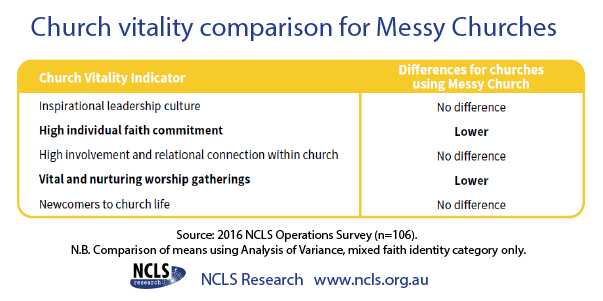One of the positives of Messy Church is that it brings together people, young and older, who might be at similar stages in life.
Characteristics of Messy Church like hands-on activities and the sharing of a meal, break down barriers and form relationships, in which to explore faith. But does the introduction of Messy Church benefit a host church?
Churches using the Messy Church format as part of their ministry were examined in terms of their characteristics, their health or vitality, along with other aspects of church life. These areas included faith identity, church vitality, openness to innovation and other features.
Faith Identity
Faith identity corresponds to different faith or theological traditions. Some churches have a predominance of one faith identity but most are mixed. Faith identity categories are useful in NCLS analysis because they are more nuanced than denominational groupings.
When looking at the characteristics of Messy Churches, results show that some eighty-five percent of churches using Messy Church were mixed in their faith identity. For instance, people in the church identified as being a mix of Catholic/Anglo-Catholic, Traditionalist, Moderate, Liberal, Evangelical, or Charismatic.
About one in eight churches using Messy Churches (13%) primarily identified with being in Evangelical or Reformed churches. Very few, two percent, were Catholic in nature.

Vital Signs
It is possible to examine Messy Churches in terms of church vitality indicators developed by NCLS Research. This was done exclusively using churches of mixed-faith to give the fairest comparison.
Areas covered are: inspirational leadership culture; a high individual faith commitment; a high involvement and relational connection within church; vital and nurturing worship gatherings; and newcomers to church life.
It was found that those churches using the Messy style were not higher on the church vitality indicators. In fact, in some respects, they might be lower. It is worth noting that the assessment was not of the Messy Church group itself, but of the whole church congregation of which Messy Church was a part.
Comparing the churches that used the Messy Church style with other ‘standard’ churches in the 2016 NCLS showed some real differences. The former was lower on two vitality indicators: high individual faith commitment; and vital and nurturing worship gatherings.

Are churches that go Messy more innovative?
There was separate analysis on the level of innovation in churches i.e. local churchgoers who agreed or strongly agreed that 'This church is always ready to try something new'. This analysis showed those using Messy more often perceived their church as innovative, rather than those that did not use the style.
Messy Church impact on other activities
It was found that churches with Messy Church activities did not generally prevent other activities from taking place. There was no indication that other activities had to make way for Messy Church. Churches that conduct Messy Church were not less likely to conduct other kinds of activities. Things like Sunday school, kids clubs and holiday programs, still featured.
The results showed that generally Messy Church was not taking resources that might be used on other activities. Rather, participating churches were more likely to conduct play groups and Godly play.
Other aspects of local church life were also examined in the 2016 NCLS. It was found that churches using the Messy format were more likely to own the building being used; share the building with non-church community groups; hold social events for families; hold faith discussion or Bible study groups; hold adult general education courses or seminars and workshops; or hold other community recreational, hobby, or leisure activities.
Conclusion
It appears from this data that the adoption of Messy Church does not necessarily impact on existing services provided by the host church. Conversely, certainly for families, there appears to be even greater opportunity for interaction and to enjoy creative worship gatherings together as a family unit.
Yet, local church leaders need to consider that the NCLS results revealed that two of the vitality indicators appeared to be lower in their congregation, these being: high individual faith commitment; and vital and nurturing worship gatherings. However as these results are not connected directly to the Messy Church activity itself, these results need to be held in that light.
Do the social benefits of Messy Church impinge on some core tenets of vitality for local churches? Or, do Messy Churches include all people, regardless of faith background, so the attenders might not necessarily hold a personal faith commitment to date, e.g. not practice regular private devotions, nor have a strong sense of 'vital and nurturing worship service' within their context?
What is clear is that the perception of innovation is high amongst churches using the Messy Church format. As churches seek to connect with those in their communities not attending traditional worship, as well as to remain culturally relevant and accessible to all, then perhaps this measure shows to some extent they are realising the goal of Messy Church.
Kathy Jacka and Sam Sterland, NCLS Research with Rod Bennett, WildHive Studios.





